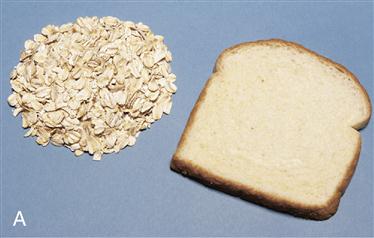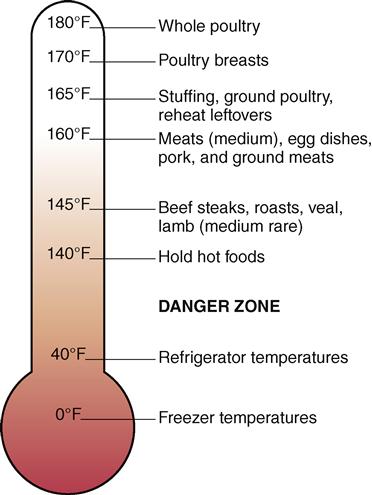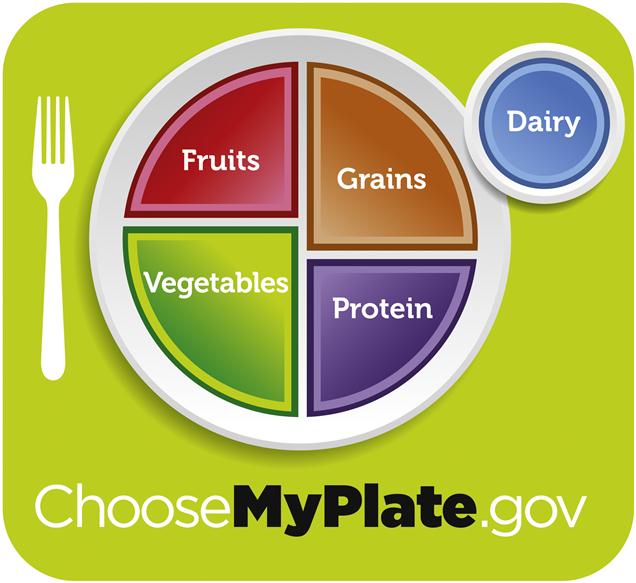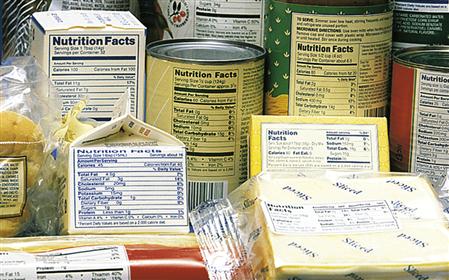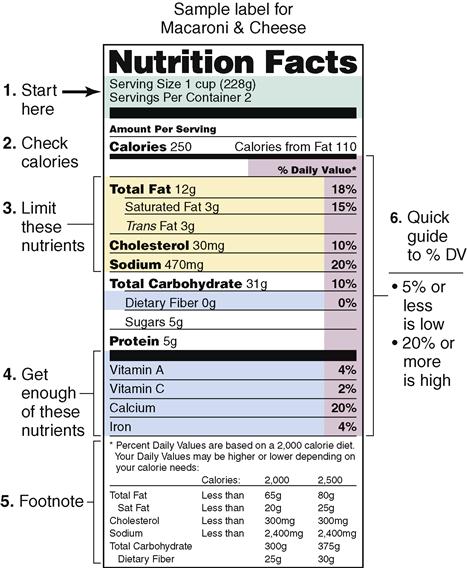Nutrition and fluids
Objectives
• Define the key terms and key abbreviations listed in this chapter.
• Explain the purpose and use of the MyPlate symbol.
• Explain how to use the Dietary Guidelines for Americans.
• Describe the functions and sources of nutrients.
• Explain how to read and use food labels.
• Describe the factors that affect eating and nutrition.
• Describe the OBRA requirements for serving food.
• Describe the special diets and between-meal snacks.
• Identify the signs, symptoms, and precautions for aspiration.
• Describe fluid requirements and the causes of dehydration.
• Explain what to do when the person has special fluid orders.
• Explain the purpose of intake and output records.
• Identify what is counted as fluid intake.
• Explain how to assist with food and fluid needs.
• Explain how to assist with calorie counts.
• Explain how to safely provide drinking water.
• Explain how to prevent foodborne illnesses.
• Perform the procedures described in this chapter.
Key terms
anorexia The loss of appetite
aspiration Breathing fluid, food, vomitus, or an object into the lungs
calorie The fuel or energy value of food
Daily Value (DV) How a serving fits into the daily diet; expressed in a percent (%) based on a daily diet of 2000 calories
dehydration A decrease in the amount of water in body tissues
dysphagia Difficulty (dys) swallowing (phagia)
edema The swelling of body tissues with water
graduate A measuring container for fluid
intake The amount of fluid taken in
nutrient A substance that is ingested, digested, absorbed, and used by the body
output The amount of fluid lost
KEY ABBREVIATIONS
| CMS | Centers for Medicare & Medicaid Services |
| DV | Daily Value |
| F | Fahrenheit |
| GI | Gastro-intestinal |
| ID | Identification |
| I&O | Intake and output |
| mg | Milligram |
| mL | Milliliter |
| NPO | Non per os; nothing by mouth |
| OBRA | Omnibus Budget Reconciliation Act of 1987 |
| oz | Ounce |
| USDA | United States Department of Agriculture |
Food and water are physical needs. They are necessary for life. The person’s diet affects physical and mental well-being. A poor diet and poor eating habits:
• Increase the risk for infection
• Increase the risk of acute and chronic diseases
• Cause chronic illnesses to become worse
• Affect physical and mental function, increasing the risk for accidents and injuries
Eating and drinking provide pleasure. They often are part of social times with family and friends. A friendly, social setting for meals is important. Otherwise, the person may eat poorly.
Many factors affect dietary practices. They include culture, finances, and personal choice. See Caring About Culture: Meal Time Practices. Dietary practices also include selecting, preparing, and serving food. The health team considers these factors when planning to meet the person’s nutrition needs.
![]() The Centers for Medicare & Medicaid Services (CMS) require that the health team assess the resident’s nutritional status. This will include:
The Centers for Medicare & Medicaid Services (CMS) require that the health team assess the resident’s nutritional status. This will include:
• Drugs that affect taste or cause dry mouth, nausea, confusion, and so on
• Weight and height (Chapter 34)
• Food intake (p. 396) and fluid intake (p. 388)
The health team then must develop a care plan to meet the person’s nutritional needs. CMS surveyors may ask you about the following. You will learn how to answer their questions as you study this chapter.
• How the person’s food and fluid intake is observed and reported.
• How the person’s eating ability is observed and reported.
• How the person’s weight is measured and reported.
Basic nutrition
Nutrition is the processes involved in the ingestion, digestion, absorption, and use of foods and fluids by the body. Good nutrition is needed for growth, healing, and body functions. A well-balanced diet and correct calorie intake are needed. A high-fat and high-calorie diet causes weight gain and obesity. Weight loss occurs with a low-calorie diet.
Foods and fluids contain nutrients. A nutrient is a substance that is ingested, digested, absorbed, and used by the body. Nutrients are grouped into fats, proteins, carbohydrates, vitamins, minerals, and water.
Fats, proteins, and carbohydrates give the body fuel for energy. The amount of energy provided by a nutrient is measured in calories. A calorie is the fuel or energy value of food:
Older persons need fewer calories than younger people. Energy and activity levels are lower.
Dietary guidelines
The Dietary Guidelines for Americans, 2010 (Box 24-1) is for persons 2 years of age and older. It is also for persons at risk for chronic disease. Certain diseases are linked to poor diet and lack of physical activity. They include cardiovascular disease, hypertension (high blood pressure), diabetes, obesity, osteoporosis, and some cancers. The Dietary Guidelines help people:
The Dietary Guidelines focus on:
• Making informed food choices
Myplate
The MyPlate symbol (Fig. 24-3) encourages healthy eating from 5 food groups. MyPlate, issued by the United States Department of Agriculture (USDA), helps you make wise food choices by:
• Avoiding over-sized portions
• Making half of your plate fruits and vegetables
• Making at least half of your grains whole grains
• Drinking fat-free or low-fat (1%) milk
The amount needed from each food group depends on age, sex, and physical activity (Table 24-1). Activity should be moderate or vigorous (Box 24-2). The USDA recommends that adults do at least one of the following:
• 2 hours and 30 minutes each week of moderate physical activity
• 1 hour and 15 minutes each week of vigorous physical activity
Table 24-1
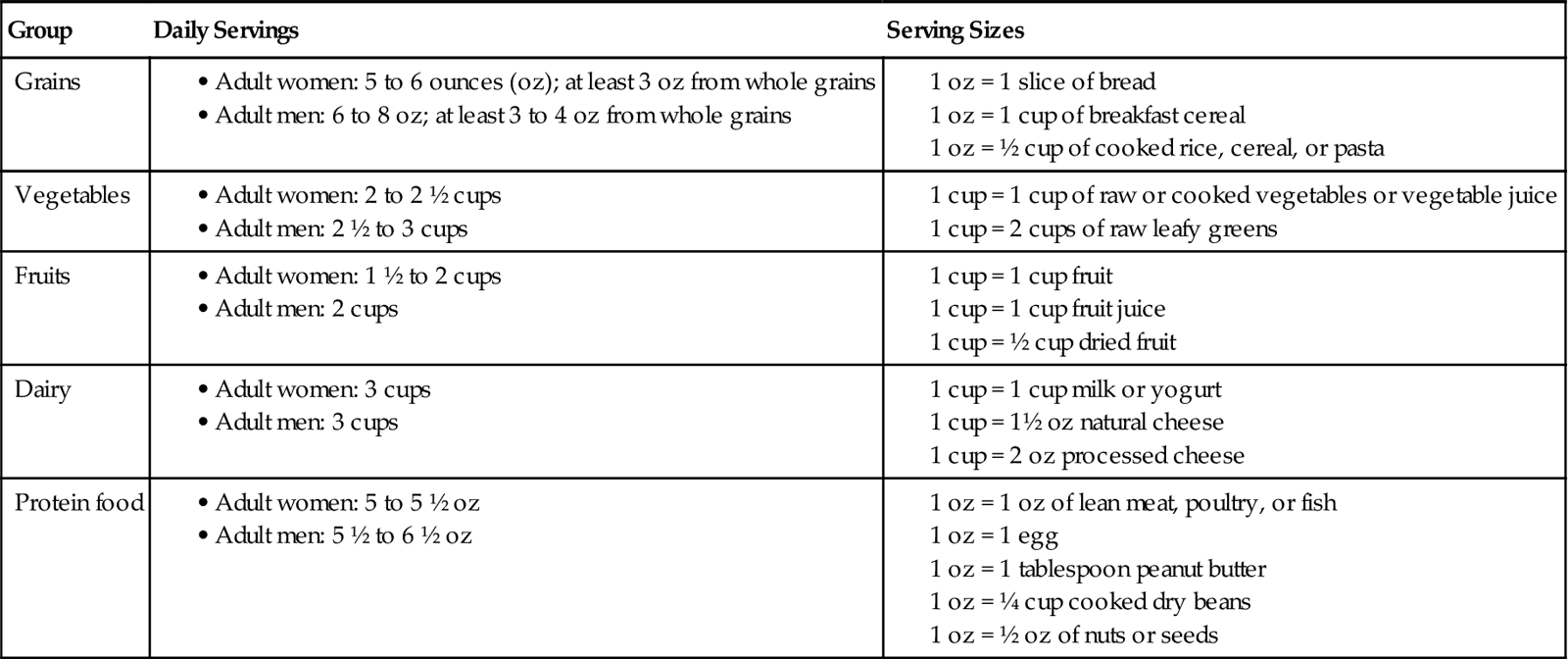
Modified from MyPlate, U.S. Department of Agriculture, June 2011.
Physical activity at least 3 days a week is best. Each activity should be for at least 10 minutes at a time. Adults should also do strengthening activities at least 2 days a week. Push-ups, sit-ups, and weight-lifting are examples.
Grains group
Food made from wheat, rice, oats, cornmeal, barley, or other cereal grain is a grain product. Bread, pasta, oatmeal, breakfast cereals, tortillas, and grits are examples. The two types of grains are:
Grains have these health benefits:
• Reduce the risk of coronary artery disease.
• May help with weight management.
• May prevent certain birth defects.
Vegetable group
Vegetables can be eaten raw or cooked. They may be fresh, frozen, canned, dried, or juice. You can eat them whole, cut-up, or mashed. The 5 vegetable subgroups are:
Vegetables have these health benefits:
• Protect against certain cancers. Cancers of the mouth, stomach, and colon-rectum are examples.
• May reduce the risk of developing kidney stones.
• May reduce the risk of bone loss.
• May help lower calorie intake. Most vegetables are naturally low in fat and calories.
• Contain these nutrients—potassium, dietary fiber, folate (folic acid), vitamins A and C.
Fruit group
Any fruit or 100% fruit juice counts as part of the fruit group. Fruit choices should vary. Fresh, frozen, canned, or dried fruits are best. Avoid fruits canned in syrup. Syrup contains added sugar. Choose fruits canned in 100% fruit juice or water.
Fruits have these health benefits:
• Protect against certain cancers. Cancers of the mouth, stomach, and colon-rectum are examples.
• May reduce the risk of developing kidney stones.
• May reduce the risk of bone loss.
• May help lower calorie intake. Most fruits are naturally low in fat and calories.
• Are naturally low in sodium.
• Contain these nutrients—potassium, dietary fiber, vitamin C, and folate (folic acid).
Dairy group
All fluid milk products are part of the dairy group. So are many foods made from milk. Low-fat or fat-free choices are best. The milk group includes all fluid milk, yogurt, and cheese. (Cream, cream cheese, and butter are not part of the group.)
Milk has these health benefits:
Protein foods group
This group includes all foods made from meat, poultry, seafood, beans and peas, eggs, processed soy products, nuts, and seeds.
When selecting foods from this group, remember:
• Using fat for cooking increases the calories. Fried chicken and eggs fried in butter are examples.
• Salmon, trout, and herring are rich in substances that may reduce the risk of heart disease.
• Liver and other organ meats are high in cholesterol.
• Egg yolks are high in cholesterol. Egg whites are cholesterol-free.
Many protein foods are high in fat and cholesterol. Heart disease is a major risk. However, this group provides nutrients needed for health and body maintenance:
Oils
Oils are fats that are liquid at room temperature. Vegetable oils for cooking are examples. They include canola oil, corn oil, and olive oil. Oils come from plants and fish. Because they have nutrients, the USDA includes oils in food patterns. However, oils are not a food group.
Adult women are allowed 5 to 6 teaspoons of oils daily. Adult men are allowed 6 to 7 teaspoons daily. Some foods are high in oil—nuts, olives, some fish, and avocados. When making oil choices, remember:
• The best oil choices come from fish, nuts, and vegetable oils.
Oils contain some fatty acids that are essential for health. Oils also are a major source of vitamin E.
Nutrients
No food or food group has every essential nutrient. A well-balanced diet ensures an adequate intake of essential nutrients.
• Vitamins—are needed for certain body functions. They do not provide calories. The body stores vitamins A, D, E, and K. Vitamin C and the B complex vitamins are not stored. They must be ingested daily. The lack of a certain vitamin results in signs and symptoms of an illness. See Table 24-2.
• Minerals—are used for many body processes. Bone and tooth formation, nerve and muscle function, and fluid balance are examples. Foods containing calcium help prevent musculo-skeletal changes. See Table 24-3, p. 380.
• Water—is needed for all body processes (p. 388).
Table 24-2
Functions and Sources of Common Vitamins
| Vitamin | Major Functions | Sources |
| Vitamin A | Growth; vision; healthy hair, skin, and mucous membranes; resistance to infection | Liver, spinach, green leafy and yellow vegetables, yellow fruits, fish liver oils, egg yolks, butter, cream, whole milk |
| Vitamin B1 (thiamine) | Muscle tone, nerve function, digestion, appetite, normal elimination, carbohydrate use | Pork, fish, poultry, eggs, liver, breads, pastas, cereals, oatmeal, potatoes, peas, beans, soybeans, peanuts |
| Vitamin B2 (riboflavin) | Growth, healthy eyes, protein and carbohydrate metabolism, healthy skin and mucous membranes | Milk and milk products, liver, green leafy vegetables, eggs, breads, cereals |
| Vitamin B3 (niacin) | Protein, fat, and carbohydrate metabolism; nervous system function; appetite; digestive system function | Meat, pork, liver, fish, peanuts, breads and cereals, green vegetables, dairy products |
| Vitamin B12 | Formation of red blood cells, protein metabolism, nervous system function | Liver, meats, poultry, fish, eggs, milk, cheese |
| Folate (folic acid) | Formation of red blood cells, intestinal function, protein metabolism | Liver, meats, fish, poultry, green leafy vegetables, whole grains |
| Vitamin C (ascorbic acid) | Formation of substances that hold tissues together; healthy blood vessels, skin, gums, bones, and teeth; wound healing; prevention of bleeding; resistance to infection | Citrus fruits, tomatoes, potatoes, cabbage, strawberries, green vegetables, melons |
| Vitamin D | Absorption and metabolism of calcium and phosphorus, healthy bones | Fish liver oils, milk, butter, liver, exposure to sun light |
| Vitamin E | Normal reproduction, formation of red blood cells, muscle function | Vegetable oils, milk, eggs, meats, cereals, green leafy vegetables |
| Vitamin K | Blood clotting | Liver, green leafy vegetables, egg yolks, cheese |
Table 24-3
Functions and Sources of Common Minerals
| Mineral | Major Functions | Sources |
| Calcium | Formation of teeth and bones, blood clotting, muscle contraction, heart function, nerve function | Milk and milk products, green leafy vegetables, whole grains, egg yolks, dried peas and beans, nuts |
| Phosphorus | Formation of bones and teeth; use of proteins, fats, and carbohydrates; nerve and muscle function | Meat, fish, poultry, milk and milk products, nuts, egg yolks, dried peas and beans |
| Iron | Allows red blood cells to carry oxygen | Liver, meat, eggs, green leafy vegetables, breads and cereals, dried peas and beans, nuts |
| Iodine | Thyroid gland function, growth, metabolism | Iodized salt, seafood, shellfish |
| Sodium | Fluid balance, nerve and muscle function | Almost all foods |
| Potassium | Nerve function, muscle contraction, heart function | Fruits, vegetables, cereals, meats, dried peas and beans |
Food labels
Most foods have labels (Fig. 24-4). They are used to make informed food choices for a healthy diet. Figure 24-5 shows how to use a food label. Food labels contain information about:
How a serving fits into the daily diet is called the Daily Value (DV). The DV is expressed in a percent (%). The percent is based on a daily diet of 2000 calories. The % DV helps you decide if a food is high or low in a nutrient. According to the Food and Drug Administration (FDA), a 5% DV is low. A DV of 20% or more is high. In Figure 24-5, a serving of macaroni and cheese is low in dietary fiber, vitamins A and C, and iron. It is high in sodium and calcium.
Factors affecting eating and nutrition
Poor nutrition is common in persons needing long-term care. They need good nutrition to correct or prevent health problems. A team approach is needed to meet a person’s nutritional needs. The nursing team, doctor, dietitian, speech-language pathologist, and occupational therapist are involved. The person is involved. So is the family if necessary. The person’s likes, dislikes, and life-long habits are part of his or her nutritional care plan.
Some of the following factors begin during infancy and continue throughout life. Others develop later.
Culture and religion
Culture influences dietary practices, food choices, and food preparation. Frying, baking, smoking, or roasting food and eating raw food are cultural practices. So is the use of sauces, herbs, and spices. See Caring About Culture: Food Practices.
Selecting, preparing, and eating food often involve religious practices (Box 24-3). A person may follow all, some, or none of the dietary practices of his or her faith. You must respect the person’s religious practices.

